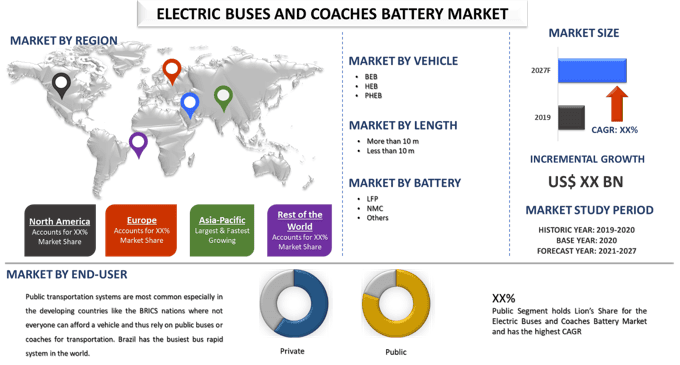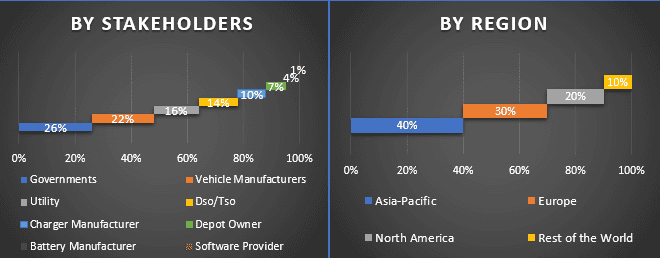- Home
- About Us
- Industry
- Services
- Reading
- Contact Us
Electric Buses and Coaches Battery Market: Current Analysis and Forecast (2021-2027)
Emphasis on Vehicle (BEB, HEB, PHEB); Length (More than 10 m, Less than 10 m); Battery (LFP, NMC, Others); End-User (Public, Private); and Region/Country

Electric Buses and Coaches Battery Market is expected to grow at a CAGR of ~12% during the forecast period (2021-2027). Latest, high-voltage, high-capacity requirements are adopting lithium-ion (Li-ion) technology because of its high energy density, small size and low weight. Using Li-ion for portable equipment offers many advantages over older rechargeable technologies. Li-ion battery characteristics include a nominal voltage of 3.6 V, thousands of duty cycles per lifetime, charge times of less than three hours, and a typical discharge rate of approximately 10% per month when in storage. It’s also important to note the size of the Li-ion bubble; it represents the many flavors of Li-ion available on the market. The specific characteristics of each Li-ion cell’s chemistry in terms of voltage, cycles, load current, energy density, charge time, and discharge rates must be understood to specify a cell that is appropriate for an application. Historically, sealed lead acid (SLA) batteries have had a few superior technical traits, in addition to their extremely low cost, that have kept them in the lead of the overall battery market. Li-ion and SLA battery markets are expected to grow over the next several years, but Li-ion is expected to overtake SLA in some areas. Li-ion battery systems are a good option when requirements specify lower weight, higher energy density or aggregate voltage, or a greater number of duty cycles. Conventional Li-ion chemistry, designed for portable applications like laptops and cell phones, is designed to offer the highest energy density by size and weight.
The key reason for the growth of the electric buses and coaches battery market is the increase in air pollution due to the rise in emission levels from vehicles has led to an increase in the global initiatives to reduce the emission level of greenhouse gases (GHG) into the atmosphere. Moreover, the transport sector contributes to about 32% of the overall GHG emission into the atmosphere. The buses and coaches that work on conventional fuel, such as diesel/gasoline, releases a large amount of GHGs after the combustion process. This has resulted in various regulations set by many regulatory bodies leading to design and development of various buses and coaches that operate on substitute fuels to cut down exhaust emission. The electric buses, hybrid buses, CNG/LNG buses, and solar buses have lesser exhaust emissions compared with the buses and coaches powered by diesel, and the emissions fall within required limit set by the regulatory bodies. This rise in government measures to limit emission levels will drive the market growth during the forecast period. The increases popularity of public transport and the use of electric buses is expected to influence the growth in the electric buses and coaches battery market.
Countries with Highest Buses and Coaches Production (Number), 2018

Zhengzhou Yutong Bus Co. Ltd., BYD Company Limited, Zhongtong Bus & Holding Company Limited, Solaris Bus & Coach S.A., Proterra Inc., Dongfeng Motor Corporation, Anhui Ankai Automobile Co. Ltd., Yinlong Energy Co. Ltd., Nanjing Golden Dragon Bus Co. Ltd., Beiqi Foton Motor Co. Ltd. are some of the prominent players operating in the Electric Buses and Coaches Battery market. Several M&As along with partnerships have been undertaken by these players to facilitate customers with hi-tech and innovative products/technologies.
Insights Presented in the Report
“Amongst Vehicle, BEV segment holds the major share”
Based on Vehicle, the Electric Buses and Coaches Battery Market is segmented into BEV, HEV, and PHEV. Hybrid electric buses combine a primary power source, an energy storage system and an electric motor to achieve a combination of emissions, fuel economy, and range benefits. The full hybrid technology can deliver part time electric buses without operational constraints. Therefore, its plays an important role in the journey towards fully electric public transport. As a technically mature technology, it can also be boosted by connectivity and geofencing to further improve the environmental and societal credentials of full hybrid buses.
“Amongst Length, Less than 10 m Segment holds the major share”
Based on Length, the Electric Buses and Coaches Battery is segmented into More than 10 m and Less than 10 m. There are various types of buses, and every one of them sports different designs and features, mostly depending on the producer of the bus. One prominent type is the single-decker bus. It is still the most commonly produced and used buses. Another type is the minibus, which is actually smaller in size and shape when compared to the single-decker.
“Amongst Battery, LFP segment holds the major share”
Based on Battery, the Electric Buses and Coaches Battery market is segmented into LFP, NMC, and Others. LFP batteries deliver at least 2500 – 3000 full charge/discharge cycles before reaching 80% of original capacity. Typical NMC batteries deliver 500 – 1000 full charge/discharge cycles before reaching 80% of original capacity. This means that LFP batteries provide FOUR times more cycle life than typical LCO batteries. LFP batteries provide superior total cost of ownership over Sealed Lead Acid (SLA) and NMC batteries.
“Amongst End-User, Public segment holds the major share”
Based on End-User, the Electric Buses and Coaches Battery Market is segmented into Public and Private. Public transportation systems are most common especially in the developing countries like the BRICS nations where not everyone can afford a vehicle and thus rely on public buses or coaches for transportation. Brazil has the busiest bus rapid system in the world.
“Asia Pacific represents one of the largest markets of Buses and Coaches Battery market”
For a better understanding of the market dynamics of the Electric Buses and Coaches Battery market, a detailed analysis was conducted for different regions across India including North America (US, Canada, Rest of North America), Europe (Germany, UK, France, Spain, Italy, Rest of Europe), Asia-Pacific (China, Japan, India, Australia, Rest of Asia-Pacific), Rest of World. Asia Pacific dominated the market and grabbed around XX% market share owing to increasing use of public transportation in the region.
Reasons to buy this report:
- The study includes market sizing and forecasting analysis validated by authenticated key industry experts
- The report presents a quick review of overall industry performance at one glance
- The report covers an in-depth analysis of prominent industry peers with a primary focus on key business financials, product portfolio, expansion strategies, and recent developments
- Detailed examination of drivers, restraints, key trends, and opportunities prevailing in the industry
- The study comprehensively covers the market across different segments
- Deep dive regional level analysis of the industry
Customization Options:
Electric Buses and Coaches Battery market can further be customized as per the requirement or any other market segment. Besides this, UMI understands that you may have your own business needs, hence feel free to connect with us to get a report that completely suits your requirements.
Table of Content
Analyzing the historical market, estimation of the current market, and forecasting the future market of the Electric Buses and Coaches Battery market were the three major steps undertaken to create and analyze the adoption of Electric Buses and Coaches Battery in major regions globally. Exhaustive secondary research was conducted to collect the historical market numbers and estimate the current market size. Secondly, to validate these insights, numerous findings and assumptions were taken into consideration. Moreover, exhaustive primary interviews were also conducted, with industry experts across the value chain of the Electric Buses and Coaches Battery market. Post assumption and validation of market numbers through primary interviews, we employed a top-down/bottom-up approach to forecasting the complete market size. Thereafter, market breakdown and data triangulation methods were adopted to estimate and analyze the market size of segments and sub-segments the industry pertains to. Detailed methodology is explained below:
Analysis of Historical Market Size
Step 1: In-Depth Study of Secondary Sources:
Detail secondary study was conducted to obtain the historical market size of the Electric Buses and Coaches Battery through company internal sources such as annual report & financial statements, performance presentations, press releases, etc., and external sources including journals, news & articles, government publications, competitor publications, sector reports, third-party database, and other credible publications.
Step 2: Market Segmentation:
After obtaining the historical market size of the Electric Buses and Coaches Battery market, we conducted a detailed secondary analysis to gather historical market insights and share for different segments & sub-segments for major regions. Major segments included in the report as Vehicle, Length, Battery, End-User. Further country-level analyses were conducted to evaluate the overall adoption of Electric Buses and Coaches Battery in that region.
Step 3: Factor Analysis:
After acquiring the historical market size of different segments and sub-segments, we conducted a detailed factor analysis to estimate the current market size of Electric Buses and Coaches Battery. Further, we conducted factor analysis using dependent and independent variables such as increased usage of public transport and bus battery production. A thorough analysis was conducted for demand and supply-side scenarios considering top partnerships, merger and acquisition, business expansion, and product launches in the Electric Buses and Coaches Battery sector across the globe.
Current Market Size Estimate & Forecast
Current Market Sizing: Based on actionable insights from the above 3 steps, we arrived at the current market size, key players in the Electric Buses and Coaches Battery market, and market shares of the segments. All the required percentage shares split, and market breakdowns were determined using the above-mentioned secondary approach and were verified through primary interviews.
Estimation & Forecasting: For market estimation and forecast, weights were assigned to different factors including drivers & trends, restraints, and opportunities available for the stakeholders. After analyzing these factors, relevant forecasting techniques i.e., top-down/bottom-up approach was applied to arrive at the market forecast about 2027 for different segments and sub segments across the major markets globally. The research methodology adopted to estimate the market size encompasses:
- The industry’s market size, in terms of value (US$) and the adoption rate of Electric Buses and Coaches Battery across the major markets domestically
- All percentage shares, splits, and breakdowns of market segments and sub-segments
- Key players in the Electric Buses and Coaches Battery market in terms of products offered. Also, the growth strategies adopted by these players to compete in the fast-growing market
Market Size and Share Validation
Primary Research: In-depth interviews were conducted with the Key Opinion Leaders (KOLs) including Top Level Executives (CXO/VPs, Sales Head, Marketing Head, Operational Head, and Regional Head, Country Head, etc.) across major regions. Primary research findings were then summarized, and statistical analysis was performed to prove the stated hypothesis. Inputs from primary research were consolidated with secondary findings, hence turning information into actionable insights.
Split of Primary Participants in Different Regions

Market Engineering
Data triangulation technique was employed to complete the overall market estimation and to arrive at precise statistical numbers of each segment and sub-segment of the Electric Buses and Coaches Battery market. Data was split into several segments & sub-segments post studying various parameters and trends in the areas of type and their type of the Electric Buses and Coaches Battery market.
The main objective of the Electric Buses and Coaches Battery Market Study
The current & future market trends of Electric Buses and Coaches Battery were pinpointed in the study. Investors can gain strategic insights to base their discretion for investments from the qualitative and quantitative analysis performed in the study. Current and future market trends were determined the overall attractiveness of the market at a regional level, providing a platform for the industrial participant to exploit the untapped market to benefit as a first-mover advantage. Other quantitative goals of the studies include:
- Analyze the current and forecast market size of Electric Buses and Coaches Battery in terms of value (US$). Also, analyze the current and forecast market size of different segments and sub-segments
- Segments in the study include areas of type and their subtypes
- Define and analysis of the regulatory framework for the Electric Buses and Coaches Battery industry
- Analyze the value chain involved with the presence of various intermediaries, along with analyzing customer and competitor behaviors of the industry
- Analyze the current and forecast market size of the Electric Buses and Coaches Battery market for the major region
- Major regions studied in the report include North America (US, Canada, Rest of North America), Europe (Germany, UK, France, Spain, Italy, Rest of Europe), Asia-Pacific (China, Japan, India, Australia, Rest of Asia-Pacific), Rest of World.
- Company profiles of the Electric Buses and Coaches Battery market and the growth strategies adopted by the market players to sustain in the fast-growing market
- Deep dive regional level analysis of the industry
Related Reports
Customers who bought this item also bought










